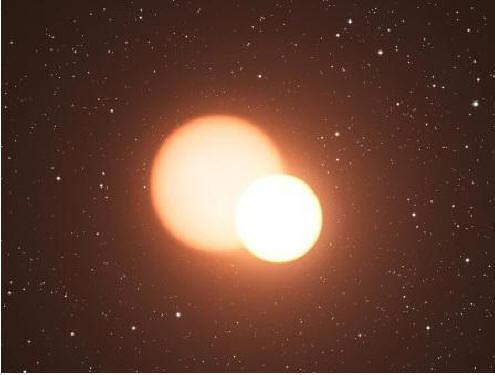|
|
|

Artist’s impression of Cepheid variable star and
its eclipsing companion.
Credit: ESO/L. Calçada
Eclipsing Cepheid Falsifies
Stellar Evolution Theory
Nov
29, 2010
Victory for one theory should
mean defeat for its rival.
An ESO (European
Southern Observatory)
press release boasts, “Pulsating Star Mystery Solved.” Cepheid variables are
stars whose rates of pulsation vary with their luminosities: the brighter the
star the longer it takes to complete a cycle of variability. It’s called the
period–luminosity relationship.
By timing the
period of pulsation, the absolute luminosity of the star can be calculated. By
comparing that quantity with the star’s apparent brightness, the star’s distance
can be determined. Edwin Hubble’s discovery of Cepheids in the Andromeda galaxy
in 1924 was the key to proving that the “spiral nebulae,” formerly thought to
lie inside the Milky Way, were actually independent galaxies far outside the
Milky Way.
Until now, two
theories that predict properties of Cepheids have been in conflict. The press
release explains: “Predictions
of their masses derived from the theory of pulsating stars are 20–30% less than
predictions from the theory of the evolution of stars. This embarrassing
discrepancy has been known since the 1960s.”
The newly
discovered Cepheid is a member of a binary system in which the two stars pass in
front of each other as seen from Earth. This configuration enables astronomers
to measure not only variations in their luminosities but also their orbital
velocities. From these measurements, the stars’ masses can be determined with
unprecedented accuracy. “The
mass of the Cepheid is now known to about 1% and agrees exactly with predictions
from the theory of stellar pulsation. However, the larger mass predicted by
stellar evolution theory was shown to be significantly in error.”
Also significant
is this last result is passed over without further comment. One can presume that
the aforementioned “embarrassing discrepancy” has paralyzed advocates’ abilities
for critical thinking. The discrepancy can only be embarrassing for an orthodoxy
of belief which admits, with false humility, that Cepheids are “not fully
understood.” The admission thinly hides the implied obverse that Cepheids are
“almost entirely understood,” a scientific conceit rightly deserving
embarrassment.
That the result
confirms the stellar pulsation theory necessitates that it falsifies the stellar
evolution theory. If astronomers were philosophically honest, they would declare
the theory nullified in accordance with Karl Popper’s 1959 proposal of
falsification as a criterion to distinguish a scientific theory from a
pseudoscientific one. Falsification was to be a “convention” that required
scientists to agree not to adjust a theory to accommodate test results but, when
falsified, to start over with searches for alternative theories. Falsification
is not a property of a theory that justifies acquiescence in orthodoxy but a
convention that enables opportunities for discovery of new theories and the
overthrow of conceptual monopolies.
But in view of
past performance, stellar evolution theory will be “adjusted.” A
substantially different theory will be put forward with the same name in order
to maintain the illusion of continuity and cumulativeness of conceptual
progress. The only continuity will be the tenure of advocates; the only
cumulativeness will be in their power and salaries. The conceptual claim is
fraudulent.
In the Electric
Universe, variations in luminosity are caused by oscillations in the currents
powering the stars and are likely “atmospheric” effects. Mass is
proportional to the charge on a body and may be unrelated to the
oscillations unless they deposit or remove charge. The process is “hardly at all
understood” and is an opportunity for discovery and development.
When Cepheids are
used as indicators for the distances to nearby galaxies, a necessary assumption
is that mass is invariant throughout the universe. But if mass varies with
charge, each galaxy—and therefore each star in it—could have a different charge
distribution with respect to the intergalactic plasma. Each galaxy could have an
idiosyncratic period–luminosity relationship for Cepheids, rendering them
unusable for determining distances to other galaxies.
Halton Arp’s
discoveries of connections between high-redshift quasars and low-redshift
active galaxies have already brought “ultra-luminous”
objects at great distances back to being “normally luminous” objects at much
closer distances. The objects may even be “under-luminous” and located at nearby
distances. With both redshift and Cepheids thrown into doubt, astronomers are
left with no reliable way to determine distances to galaxies. Astronomy is
once again open to new fundamental insights.
The ornate knowledge with which the
Queen of the Sciences has proclaimed
herself to be draped is turning out
to be invisible. Perhaps she should
not have paraded herself so far down
the street without an alternative
theory at hand.Mel Acheson
|
|
|
|
|
|
|
|
|
YouTube video, first glimpses of Episode Two in the "Symbols of an Alien Sky"
series.
|
|
|
|
|
|
|
Three ebooks in the Universe Electric series are
now available. Consistently
praised for easily understandable text and exquisite graphics.
|
|
|
|
|
|
|
|
|
|







